Tutorials: How this made
Step by Step Tips
Searching for reliable sources
It consists in finding the technical characteristics of a model in order to reproduce it at 1/24, the current scale of modelling in this field and an appreciable comparative element. It should be noted that complete ribs are desirable, but a simple wheelbase is sometimes enough, associated with a photo of suitable profile. The Eye, an advanced instrument, takes care of the rest. A good iconography is of course the indispensable complement of any technical drawings manufacturer. In this regard, the Internet is a rather extraordinary data bank, for the trouble that we want to surf the time necessary for a one-off search, a "photo safari", especially on vehicles whose documentation is scarce. Some sites of enthusiasts are from this point of view of the gold mines for who is interested.
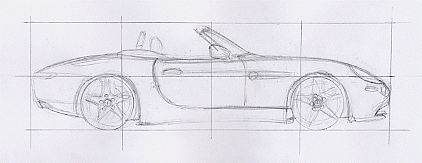
Preparing the base
This is to center on the sheet, usually an A4, the car whose measurements of height and length make it possible to draw a rectangle in which it will register. Then, and always in pencil, preferably a criterion of type "H", which is greasier, and therefore more easily erasable, a compartmentalization of the rectangle is made, its separation into eight equal parts, in order to reproduce the model while respecting the The same work will have been carried out beforehand on a photo with a clear profile of the model.To begin and educate his eye, it is better to cut this rectangle in 16 or even 32 equal parts, in order to be sure Not to get away from the lines of the car.

Pencil Drawing
This is always done with the same criterion. It is the reproduction of the lines of the vehicle at the fairest, relying on the grid of the photo or the basic technical drawing. With time, and practice, one becomes accustomed to find a certain systematization of proportions according to the models, one recognizes the design, the "paw" of an era or a bodybuilder. As a general rule, when the model is a front engine, the length of the hood means that the windscreen is mounted in the middle of the grid. Similarly, the diameter of the wheels is generally always less than the transverse half of this grid. When it exceeds this limit, there is a marked accentuation of the sporting character, referring to a model of race adapted to the road, more than road. For most GTs, the guns of elegance make the rear overhang more important than the front, which generally places the hub of a wheel on the bottom quarterback of the grid. There are many other examples. Just as there are "canons" of classical morphology since antiquity, the aesthetics to somewhat evolved, and it is even more true in the Automotive Design, but the true elegance remains timeless. All you have to do is stroll through the competitions of elegance, compare a Bugatti 57 Atlantic with a Ferrari 550 Maranello.

Technical Drawing
This is the most accurate part of the drawing. It is a matter of ironing with a special ink-ink pen with a fine point, of the "Rotring" type or related in the pencil drawing, so as to have a base that will allow the pencil to be erased in order to 'Avoid traces during the next painting by playing on the transparency of the sheet. These lines are made with different points of increasing size depending on the parts to be inked. Thus, the contour of the wheels as well as their passages will be thicker to allow a painting (black) more efficient, faster. A 3.5mm mine is suitable in this case. On the other hand, for all that concerns the more "exposed" parts of the drawing, the finest stroke is suited for the paint to be superimposed on itself by limiting itself at the same time. A thicker stroke would have a coarse appearance here, showing through the paint. Here, the 0.1 mm mine, the smallest existing one, is suitable, as is the one of 0.2. It is useless to dwell on the details, which will be added on the painting later. The indispensable instruments are the compass, for the wheels and their passages, preferably precise, with wheel and universal adapter. The square and the "parrot", the curved gauge will also be of great use..

Painting
This is by far the biggest job, the most technical, but also the most pleasant. The coloring requires a choice of photos well suited to the final rendering sought. It is obvious that a photo "studio", as beautiful as it is, is totally artificial by the game very raw, very slice of the lights of the projectors. Nothing beats the natural lights, those by which one expects to see a model in general, and which do not cheat on the proportions and the curves. The midday sun is no more preferable than the early hours of the morning or the tawny shades of the evening. They tend to deceive the body color. A blue or mixed sky around ten or fifteen hours in mid-season is truly ideal. Depending on the environment, the effects sought may nevertheless accentuate the metallic appearance and the shapes by a good restitution of the play of reflections. If the gouache is the base material, preferably fine, concentrated in pigment, the acrylic may very well be suitable, provided that it is matt. For large models, the airbrush makes it possible to obtain "impeccable" rendering, but everywhere else the dexterity with the brush prevails. A dozen brushes made of hammer brush allow a greater fineness in the work, a 12 serving only the side of the bodywork, and a 1 suitable only for the finishing details: bolts, points of light, inscriptions. Traditional liquid china ink is preferable for tires. It will allow to contrast with the matt black paint of the fairly realistic wheel arches. By playing with the transparency of the sheet, it will be possible to give volume to the latter which will be accentuated by the reflection of light, remaining relatively discreet so as to reproduce the matte appearance of the rubber. Similarly, combining the ink and gouache on the glass parts of the car can accentuate the shine.

Finishing Job
The BMW 507 is here evoked with happiness by the heavy and elitist Z.8. This last step will see the use of fine brushes and the pen 0.1 in order to perfect the sharpness of the lines. It is a work of attention that makes it possible to achieve a greater correspondence with the photo model. It is neither more nor less than the work of the American painters who invented "photorealism". Depending on the quality of the documents, this can prolong the work considerably.
Creation of a neo-classical design
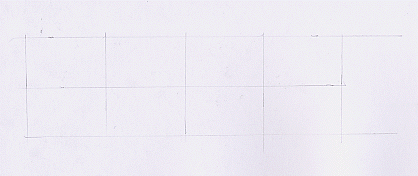
Preliminary frame
Here is the basic work grid: For a 1 / 24th car illustration by setting a "cannon" frame: Draw a rectangle of 16cm x 5cm (which corresponds in real size to 3.84 meters of Long for 1.20 high, a small GT that would be satisfied with a 120-140cv engine for already interesting performance: If its chassis was based on Aluminum, as well as its structure, with a bodywork of fiber Of glass, no doubt that its weight would be less than a ton, all full. Its front engine for reasons of cost would allow it the adoption of a common mechanical: A Peugeot 206 S16 engine would do the trick, Its grip would be easy for the uninitiated and it would play the card of originality with its "classic" look and its long bonnet, in front of vehicles all with central engine, its price would be all proportions kept under The barrier of 30 000 Euros, A cinematic coupe cabriolet, its relative versatility (It will be a pure berlinette, a two-seater, a "car of selfish") destined it to a wide audience. The above frame is divided into eight equal parts, practical to locate the position of the different elements, in order to respect ideal proportions.
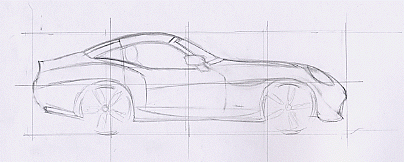
Design fundamentals
In this grid, the guns of classical elegance require that the hub of the rear wheel be placed in the middle (starting from the left to the right), at the bottom of the first subdivision, the windshield astride the top of the Subdivision and the top of the wheels on the longitudinal median at the center of the drawing. This is of course only valid for motor cars before. For a central motor vehicle, the proportions differ somewhat. It is customary in particular to have a reduced overhang at the rear and longer at the front, the reverse of the classic elegance of the front engines. It is the pace of fawn picked ready to leap that takes precedence.
The cockpit is seen here, rather small. Smallness, difficult access, firm suspensions and large-diameter rims are typical defects, character traits that identify a sportsman, and which are sought as Part of the unconscious and the collective memory. She is all forgiving by her driving pleasure, distilling the pure pleasure that makes her necessarily endearing in the long run. There are two fundamental philosophies that are opposed:
-The first is to design a four-seater coupe plush and to ensure the performance adequate to its rank, equipping it with a large displacement. In fact, for an average weight of 1600 to 1800kgs, an engine developing between 250 and 400cv is necessary in order to validate the conditions for access to the Grand Touring club: The 0 to 100 Km / h crossed in less than six seconds and A top speed of more than 220 km / h. In this case, the car is as comfortable and efficient as it is expensive and expensive to buy. This type of vehicle in general is between 60 000 and 100 000 Euros (Mercedes CL and CLK, BMW 8 Series, M3, Ferrari 456M GT, Maserati coupé, etc..)
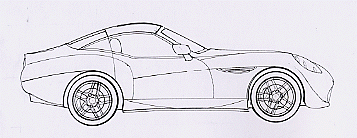
-The second is not to reconcile the performance of a sportsman with the advantages of a sedan, but to seek efficiency with a standard engine without inflated. For this, the only solution is lightening. Size, habitability, materials, structure, everything must be taken into account. But this philosophy, closer to true sportsmanship, has the advantage of being quite "cheap" if, for the comparative price level, the Spartan and rudimentary side is ignored, "apple crude" Of vehicles built. (Alpine A110, Porsche 956, Abarth 1000GT, Lotus super seven for the history, and Lotus Elise / Exige, Opel Speedster, Hommel RS, PGO Speedster II, Venturi Fetish, etc., for the modern ones.)
The pronounced side of the wings, with sensual curves are of "classic" inspiration. (The design of the sixties is, in my opinion, the most evocative, especially among the Italian coachbuilders, masters of the elegance of the line that remained, Pininfarina, Bertone, Vignale, Giugiaro, Zagato, Touring, Ghia, Torch craftsmen working on quotations to satisfy the most extravagant desires of the great ones of this world, the French Chapron, Figoni and Falaschi, Saoutchik, Bugatti, Fernandez and Darrin, Letourneur and Marchand ...) The "Edge design" launched By Claude Lobo, then the head of Design Ford Europe, who signed the Cougar and Puma coupons, re-energized the reassuring but very soft "bio-design" style of the late 80s and early 90s in response to the "corner line" Nuccio Bertone in the seventies, too aggressive, artificial, functionalist but devilishly modern, as it contrasted with the "natural" lines more aerodynamic from the 1930s to the 1960s.
The "Edge design", at the beginning simple reinsertion of lines and curves trenches, seems, especially if we see what happens at Cadillac, to a real return to this corner line, but with the surface purity of the diamond . By eliminating mirrors and door handles, we are trying to get closer to stealth planes, which does not have to be functional, but has a "high-tech" side that appeals well under the lights of the booths Of lounges. We should not forget the long-standing relationships that the automobile has with aviation, always envious of its advances, which it adopts with a lag of the order of ten years.
The model presented here is an avatar of the "classic" design, treated with modern aspects: -The curves are inspired by those curved wheels that have evolved since the 1920s, those above the front wheels falling originally at the foot of the rear trains, dying at the bottom of the "hips" of the car, One of the most sensual and evocative parts of feline power, like hind legs folded before the bound ... by the narrowing of the rear window, this effect is accentuated from the rear. It is no coincidence that the wild beasts have been the most inspiring animals, the most used in the semantics and the automobile symbolism, since the 30s
-The "mouth" of the front, ovoid shape and crossed by a chrome grille will add to the "carnivore" side of the grille, which acute almond optical blocks and oblique towards the center-look dear to the mark of Sochaux-, will be completed. -The long hood housing a "purring" mechanism will be shaped in three parts, the wings, and the hood proper, surmounted by a central air intake to accentuate the sporting aspect. This proportion of the hood, drawn from numerous historical examples such as the Jaguar type E or the Toyota 2000 GT, have an equally immemorial virile symbolism. - The lateral gliding sloping towards the center rests on the rear wing, in a resolutely "Edge design", while evoking the Delage Aérosport. It is curious to note that all the lines of force have been reversed since the 1930s. At the time, the hood took up space and the rear "in trolley" was elegant. This remains true for the current models Equipped with a long trunk. The start of these lines was located at the bottom of this "trail", climbed up the passenger compartment and emphasized the length of the hood. Since then, they originate at the top of the trunk and come to die at the bottom of the hood. This is particularly relevant to the latest Mercedes.
- The lateral apertures also very sliced will emphasize the break of the front wing while recalling that this elegant accessory is present in many forms on many G.T. with front engine. -The modest rear spoiler has the advantage of allowing an effective aerodynamic support while preserving the silhouette of a flap as prominent as unsightly. -The "mustaches" above the front wheels originate at the bottom and in the center of the grille. Without being a "crumb trap" of a racing beast, this accessory will aim to stick the car to the ground, to make more precise and incisive its handling. -The profiled sill panels remain relatively discreet while having the same role as the accessories mentioned above, in the spirit "AMG", the Mercedes preparer - good-tone functionality. -The modern-style five-spoke wheels have become a "classic" value after the famous Borrani wire wheels, and their fine-cut caesura reminds them without going as far as the heavy evocations of the BBS wheels..
-The rear part is made up of two distinct parts, a low, domed, since it constitutes the zone of deformation of the stern under which one finds the chrome exhaust pipes (Four would be of the best effect but more noisy than indispensable for A small four-cylinder ...). In their alignment, above are the rear lights in the form of red blocks of round shape, still well-known reference, inside a concave sternboard which contrasts well with the lower part and also accumulates the clasps look
-The inside of the cockpit could be "warm" in the colors of its upholstery, beige, bright red, black, the use of stitching in a different color would give a look to bucket seats dressed in leather Preferably. The Conolly leather of an excellent effect would be moved however for a vehicle of this range; When the materials of marquetry, the most noble varnished woodwork would certainly not be of walnut or elm essence, but of something more modest, but which saves appearances. Let us not forget that the dashboard of the Facel-Vega was painted wood. Inserts of brushed aluminum would also be welcome.
Painting
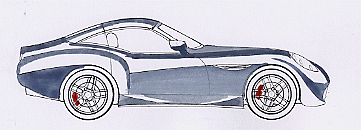
1-Laying dark shades.
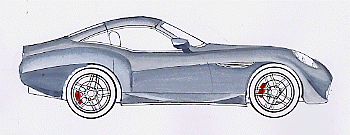
2- Laying the shades clear and degraded.
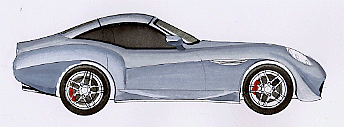
3-Laying ink of China.
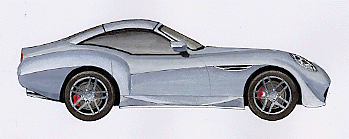
4-Window gradient and work on the rims.
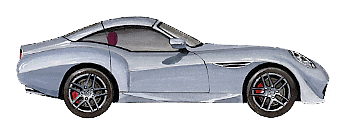
5-Finishes: Last details and reinforcement of the reflections and the metallic aspect of the body to the white gouache.

Detail of the front wheel finish. The use of Chinese ink makes it possible to bring out the curve of the wheel and its "rubbery" appearance in contrast with the wheel passage treated in black gouache.

Detail of the wheel after finishing: The reflection of the tire is accentuated with a worked tip of white gouache. A point of light on the edge of the rim indicates the direction of the light source, accentuating the "metal" aspect of it. The clamping nuts are re-wound, the edges of the branches specified.